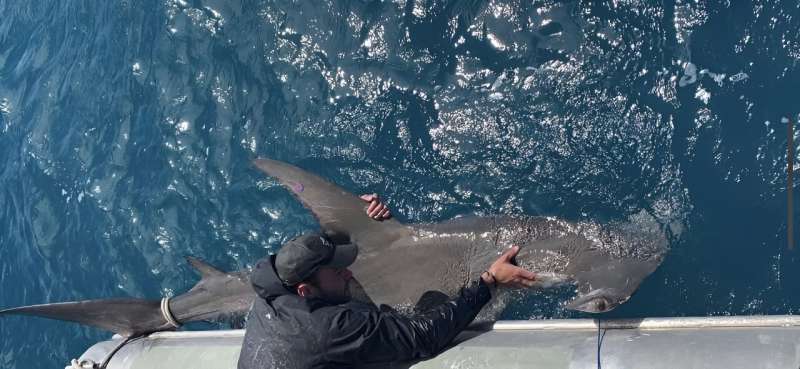This article has been reviewed according to Science X's editorial process and policies. Editors have highlighted the following attributes while ensuring the content's credibility:
fact-checked
peer-reviewed publication
trusted source
proofread
Stingray diet keeps great hammerhead sharks close to shore

New research from James Cook University shows great hammerhead sharks spend much of their time in the shallows of the Great Barrier Reef to feed on a bountiful supply of stingrays.
JCU Ph.D. student Nicolas Lubitz tracked more than 30 of the species over a four year period in waters across central and northern Queensland, finding that the species largely stayed in the area to hunt juvenile stingrays in the coral reef flats and mudflats of the Great Barrier Reef. The paper is published in the journal Frontiers in Marine Science.
"The majority of the sharks we were tracking remained very local and their diet information shows they are really reliant on stingrays," Lubitz said.
"Off the east coast of northern Australia, stingrays are very abundant in the shallows all year round and that's what the hammerheads are capitalizing on. For the first time, we are combining multiple data streams to confirm this.
"We took tissue samples from the sharks and stingrays and they had similar chemical signatures which means they're in the same food web and that's how you can indicate they are feeding on the stingrays."
Locations where the great hammerheads were tracked included North-West Island, Heron Island, the Whitsundays, the Palm Island Group, and off the coast of Cairns.
"Sharks are not the kind of animal that needs to eat three times a day, so they still maintain decent home ranges to patrol and if there's a food opportunity that comes up that is not a stingray, they will hit it," Lubitz said.
"But the hammerheads probably know where the stingrays are, because the rays are abundant year-round and they know at what tide they can best access them in the shallow coastal habitats."
Lubitz said the movements of the great hammerheads were compared to 36 bullsharks that were also tracked, showing a sizable difference in the distances traveled by each species.
"We know that some bull sharks were traveling towards southern NSW, near Merimbula and Narooma, and then four or five months later they would ping in at northern Cape York. So that's about a 7000 km round trip that they do every single year," he said.
"The longest hammerhead movement we got was from one called 'Lucy' when she traveled from North-West Island, near Gladstone, up to the Palm islands. She was there for about two weeks and then she sprinted back to North-West Island. That's about a 750 km trip."
"Lucy" is, to the team's knowledge, the world's first great hammerhead shark to be fitted with both a satellite tracker and an internal acoustic tracker, giving unprecedented insight into the movements of the critically endangered species.
She joins more than 30 great hammerheads who have been tagged by the team since 2019, including a 4.55m long specimen—the largest of the species to ever be tracked in the world.
Lubitz said he would now like to track great hammerheads off the coast of Moreton Bay near Brisbane in a future study to better understand their movements in sub-tropical conditions.
Stay up-to-date with Lucy's movements by heading to biotracker.biopixeloceans.org/, clicking on the shark icon and selecting which shark to track.
More information: Nicolas Lubitz et al, Trophic ecology shapes spatial ecology of two sympatric predators, the great hammerhead shark (Sphyrna mokarran) and bull shark (Carcharhinus leucas), Frontiers in Marine Science (2023). DOI: 10.3389/fmars.2023.1274275
Journal information: Frontiers in Marine Science
Provided by James Cook University





















